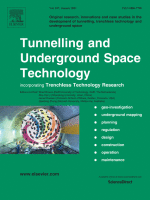
New publication in Tunnelling and Underground Space Technology
In the January issue of the journal "Tunnelling and Underground Space Technology" the article "From digital models to numerical analysis for mechanised tunnelling: A fully automated design-through-analysis workflow" has been published.
Large infrastructure projects involving the construction of tunnels in urban areas constitute complex, integrated and multi-disciplinary systems, which require building and construction information modelling as well as computational design assessment tools for decision making during all project phases and during their complete life cycle. Even if the underlying information needed for computational analysis is stored in an information model, the translation to computational models is still cumbersome and requires significant manual work for model generation and set-up as well as excessive computing resources and time. To address these shortcomings, this paper presents a systematic summary of concepts for integrated information modelling, numerical analysis and visualisation for urban mechanized tunnelling. Our first approach “BIM-to-FEM” is characterised by a fully automated link for error-free data exchange between a standalone Tunnelling Information Model and the process-oriented simulation model for mechanized tunnelling “ekate”. In the second approach “SATBIM”, a fully automated data exchange workflow is established between a parametric multi-level information model for tunnelling and multi-level numerical models based on both Finite Element and Isogeometric Analysis, where meta models are employed for real-time design assessment. We discuss the different applications of these concepts, such as scenario-based exploration of design alternatives, real-time design assessment within a TIM based on meta-models, and the potentials of using these models for the process control during construction. Furthermore, we present two case studies where real project data has been used for the integration of information and numerical modelling. The examples in this paper indicate clear advantages of this approach compared to traditional approaches in terms of efficiency of modelling achieved by reduced user interactions and error-free information exchange, and show the benefits of multi-level model representation and real-time analysis tasks.
More information can be found here.
